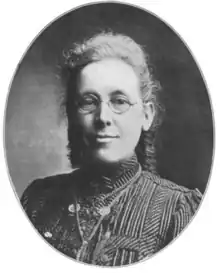Saleni Armstrong-Hopkins
Saleni Armstrong-Hopkins (born January 21, 1855), born Saleni Armstrong, and sometimes seen as Salini Armstrong-Hopkins, was a Canadian-born American physician, medical missionary, and author.
Saleni Armstrong-Hopkins | |
|---|---|
 Saleni Armstrong-Hopkins, from a 1908 publication. | |
| Born | Saleni Armstrong, Salini Armstrong-Hopkins January 21, 1855 London, Ontario |
| Occupation(s) | Physician, author |
| Relatives | Zamin Ki Dost (sister) |
Early life and education
Saleni Armstrong was born in London, Ontario, the daughter of William Leonard Armstrong and Elizabeth Summers Armstrong.[1] Her father was a Union Army surgeon during the American Civil War.[2] She was raised in Michigan and Nebraska.[3]
Armstrong attended Northwestern University for a year and graduated from the Woman's Medical College of Pennsylvania in 1885, with an internship in gynecology and obstetrics at the Philadelphia Lying-in Charity Hospital.[4] She also studied at Mount Vernon Institute of Elocution and Languages.[5]
Career
Armstrong founded and ran an orphanage in Platte County, Nebraska, as a young doctor. She became a medical missionary in India as a single woman in 1886, serving with her sister Willimina L. Armstrong,[6][7] and later with her husband, Methodist clergyman George Armstrong-Hopkins. She founded and directed a hospital and a nurses' training school at Khetwadi from 1887 to 1889. She was physician in charge at Lady Atchison Hospital in Lahore and a hospital in Hyderabad, Sindh from 1889 to 1893.[8] From 1893 to 1895, she was on the staff of a hospital in Omaha. She sponsored several Indian students to attend college in the United States.[5] The Armstrong-Hopkinses went to Bombay in 1912; she retired from the mission field after her husband's death in 1918.[9]
In 1899, Armstrong-Hopkins sued her superior, Methodist bishop James Mills Thoburn, for slander.[10] She sued him again in 1907 for libel, and won an award of $500.[11][12] Thoburn had claimed that Armstrong-Hopkins was spending lavishly on dresses, stockings, shoes, and hats for her Indian patients.[13] She held a medical license in Nebraska from 1894,[14] but was refused a license to practice in Washington, D. C. in 1903, when the district's board of medical supervisors questioned her credentials and asked her to sit for an examination.[15]
Books by Armstrong-Hopkins[4] included Within the Purdah (1898),[16] Fruit of Suffering (a book of poems), Pork and Mustard, and Khetwadi Castle (1900).[17] She gave lectures on her experiences in India to women's groups and at church events.[18]
Personal life
In 1893, Saleni Armstrong married George Franklin Hopkins (1855-1918), as his second wife.[8] They both used the surname Armstrong-Hopkins after they married, and their legal change to the hyphenated surname made headlines in 1905.[19][20] In 1926, she was on a list of "Lost Alumnae" of the Woman's Medical College of Pennsylvania; her alumnae association had lost track of her address.[21] Her younger sister Willimina Leonora Armstrong was known later in life as Zamin Ki Dost, a physician, writer, and lecturer on Eastern mysticism, based in Los Angeles.[22]
References
- Leonard, John William; Marquis, Albert Nelson (1906). Who's who in America. A.N. Marquis. pp. 47–48.
- "American Woman in India". The Spokesman-Review. 1897-05-16. p. 11. Retrieved 2020-09-16 – via Newspapers.com.
- Leonard, John William; Mohr, William Frederick; Holmes, Frank R.; Knox, Herman Warren; Downs, 0infield Scott (1905). Who's who in New York City and State. L.R. Hamersly Company. p. 27.
- Moulton, Charles Wells (1906). The Doctor's Who's who. Saalfield publishing Company. pp. 13–14.
- Herringshaw, Thomas William (1904). Herringshaw's Encyclopedia of American Biography of the Nineteenth Century: Accurate and Succinct Biographies of Famous Men and Women in All Walks of Life who are Or Have Been the Acknowledged Leaders of Life and Thought of the United States Since Its Formation ... American Publishers' Association. pp. iv.
- Isham, George W. (1893). Two Years in India, Or, Some Missionary Lessons, and how They Were Learned. author. p. 42.
- Gurantz, Maya (31 May 2017). "Mothers of Magic". Los Angeles Archivists Collective. Retrieved 2020-09-16.
- Beauchamp, William Martin (1908). Past and Present of Syracuse and Onondaga County, New York: From Prehistoric Times to the Beginning of 1908. S.J. Clarke Publishing Company. p. 696.
- Williams, D. Newell; Foster, Douglas Allen; Blowers, Paul M. (2013-03-30). The Stone-Campbell Movement: A Global History. Chalice Press. ISBN 978-0-8272-3527-4.
- "Bishop Sued for Slander". Buffalo Courier. 1899-12-16. p. 1. Retrieved 2020-09-16 – via Newspapers.com.
- "BISHOP MUST PAY HER $500.; Dr. Saleni Hopkins Sued Churchman for $100,000, Alleging Libel". The New York Times. 1907-12-13. ISSN 0362-4331. Retrieved 2020-09-16.
- "Bishop Guilty of Libel". The Baltimore Sun. 1907-12-13. p. 5. Retrieved 2020-09-16 – via Newspapers.com.
- "Fluffies in Bombay". Syracuse Herald. December 9, 1907. p. 6. Retrieved September 16, 2020 – via NewspaperArchive.com.
- "Licensed Physicians". Lincoln Semi Weekly State Journal. January 12, 1894. p. 3. Retrieved September 16, 2020 – via NewspaperArchive.com.
- "Adheres to Decision". Evening Star. 1903-08-10. p. 8. Retrieved 2020-09-16 – via Newspapers.com.
- Hopkins, Saleni (Armstrong) (1898). Within the purdah;also, In the Zenana homes of Indian princes, and Heroes and heroines of Zion;. New York. hdl:2027/loc.ark:/13960/t4bp0s18q.
- Hopkins, Saleni (Armstrong) (1900). Khetwadi castle, sequel to "Pork and mustard." vol. II. The Library of Congress. Syracuse, N.Y., C. W. Bardeen.
- "Lecture for Women". Fort Worth Star-Telegram. 1912-09-24. p. 7. Retrieved 2020-09-16 – via Newspapers.com.
- "Takes Wife's Maiden Name". The Daily Mail (Bedford, Indiana). 1905-05-08. p. 2. Retrieved 2020-09-16 – via Newspapers.com.
- "Change Authorized". Evening Star. 1905-03-11. p. 16. Retrieved 2020-09-16 – via Newspapers.com.
- "Lost Alumnae" (PDF). Bulletin of the Woman's Medical College of Pennsylvania. 77: 11. November 1926.
- Ellerbe, Rose L. (1911-06-06). "Willimina Armstrong". The Los Angeles Times. p. 23. Retrieved 2020-09-16 – via Newspapers.com.